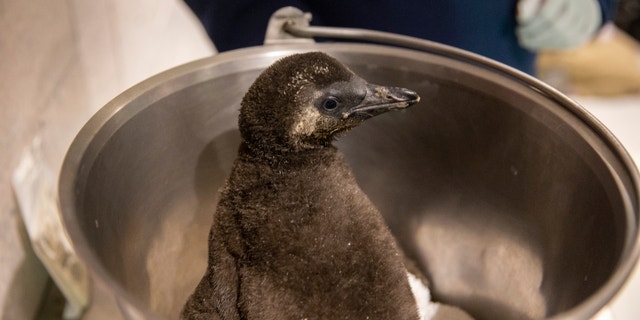ARC's small nuclear reactors won't fill electricity gap left by Belledune
CEO says company’s current plan would still leave ‘shortfall in megawatts’ after coal phaseout
One of the companies planning to build small modular nuclear reactors in New Brunswick says its technology won't be enough to replace all the electricity N.B. Power is now generating with coal.
The provincial government has touted SMRs as a key element of its climate action plan to shift away from generation that emits greenhouse gases that warm the atmosphere.
"Our mission is to protect the planet with clean energy," ARC Clean Energy CEO Bill Labbe told MLAs on the legislature's standing committee on climate change.
But Labbe said the company's plans do not include enough SMRs to make up for the 450 megawatts of electricity generated annually by the Belledune coal-fired power station.
"No, I think there's a significant shortfall in megawatts," he told reporters. "That shortfall will require hundreds of megawatts of new generation."
Belledune must stop burning coal by 2030, creating a potential gap in the province's electricity generation.
Labbe said ARC is confident its first SMR will be operating at Point Lepreau by then, but it will only generate 100 megawatts of electricity.
The company plans to have eight to 12 SMRs in Belledune eventually, but they probably won't be in place until 2032 to 2036.
And all their output will be for a proposed plant to generate hydrogen power for export — meaning it won't be available for the N.B. Power grid.
The other New Brunswick-based SMR developer, Moltex Energy, says it is "on its way to having an operational reactor by the early 2030s."
Committee already warned
Last year, a former N.B. Power CEO and a vice-president at Saint John Energy both warned the same committee that costs and regulatory processes could prevent SMRs from being ready in time for 2030.
Labbe said other SMRs could be set up in New Brunswick to generate more electricity for the grid but there's nothing on the drawing board for that yet, and that means they wouldn't be operating by the time coal is phased out.
And he said because every unit after the first Lepreau unit will be subject to federal, not provincial, environmental assessments, the process will take more time — unless ARC can persuade Ottawa to adopt an accelerated regulatory process.
He said that would not mean cutting corners on safety but perhaps allowing for licensing and permitting to happen for several units simultaneously.
"We believe there's opportunity to make that process efficient, that's all.… but we still want to ensure that we are following all of the expectations," he said. "We just think that we can do it in an efficient sort of way."
Labbe made the comment during the first of four days of meetings of the climate change committee. Two days are being devoted to small modular reactors.
Total of $30M from province
The Higgs government gave ARC $20 million in 2021, adding to the $10 million it received from the previous Liberal government. Labbe told MLAs Tuesday that ARC won't need any more public money from now on.
Tuesday's committee session featured a testy exchange between Energy Minister Mike Holland and anti-nuclear activist Susan O'Donnell of the Coalition for Responsible Energy Development in New Brunswick.
Holland said O'Donnell is proposing an alternative energy plan, renewable power plus large-scale battery storage, that is no more proven or viable than small reactors.
"Storage for renewables is as far out on a trajectory on a cost-effective basis as SMRs," he said.
"So what you're talking about doing is something that is unrealistic for the current day and age."
The CRED-NB proposal is for new battery technology to store electricity from solar and wind power that could then be used on days when it's not windy or sunny.
"The technology is very expensive right now for storage, but the costs are dropping rapidly, at the same time that the costs are dropping rapidly for solar and wind, they're dropping for storage," O'Donnell said.
Holland argued that each SMR built will be less expensive than the previous unit, driving costs down so that eventually "the nth of a kind" won't be as costly as a first-of-a-kind large battery storage facility.
The minister said both technologies may eventually be viable, so "why wouldn't we go down both tracks simultaneously?"
"Well, minister, you're assuming there will be an nth-of-a-kind [SMR]," O'Donnell said.
"Well, you're assuming there won't," Holland answered.
O'Donnell said experts appearing later at the committee meetings would be better able to answer questions about the cost of a renewable-plus-storage option for electricity generation.
"It's really not up to us, a volunteer group, to come up with a Plan B," she told reporters later. "This is what N.B. Power should be doing. This is what the ministry should be doing."



:format(webp)/https://www.thestar.com/content/dam/thestar/news/canada/2023/02/20/why-has-a-canadian-company-partnered-with-the-tiny-island-of-nauru-to-fast-track-deep-sea-mining/_2nodule_collector_vehicle.jpg)
:format(webp)/https://www.thestar.com/content/dam/thestar/news/canada/2023/02/20/why-has-a-canadian-company-partnered-with-the-tiny-island-of-nauru-to-fast-track-deep-sea-mining/_3gerard_barron.jpg)
:format(webp)/https://www.thestar.com/content/dam/thestar/news/canada/2023/02/20/why-has-a-canadian-company-partnered-with-the-tiny-island-of-nauru-to-fast-track-deep-sea-mining/_5nodule.jpg)
:format(webp)/https://www.thestar.com/content/dam/thestar/news/canada/2023/02/20/why-has-a-canadian-company-partnered-with-the-tiny-island-of-nauru-to-fast-track-deep-sea-mining/_4hidden_gem_ship.jpg)
:format(webp)/https://www.thestar.com/content/dam/thestar/news/canada/2023/02/20/why-has-a-canadian-company-partnered-with-the-tiny-island-of-nauru-to-fast-track-deep-sea-mining/atop_the_nodules.jpg)













